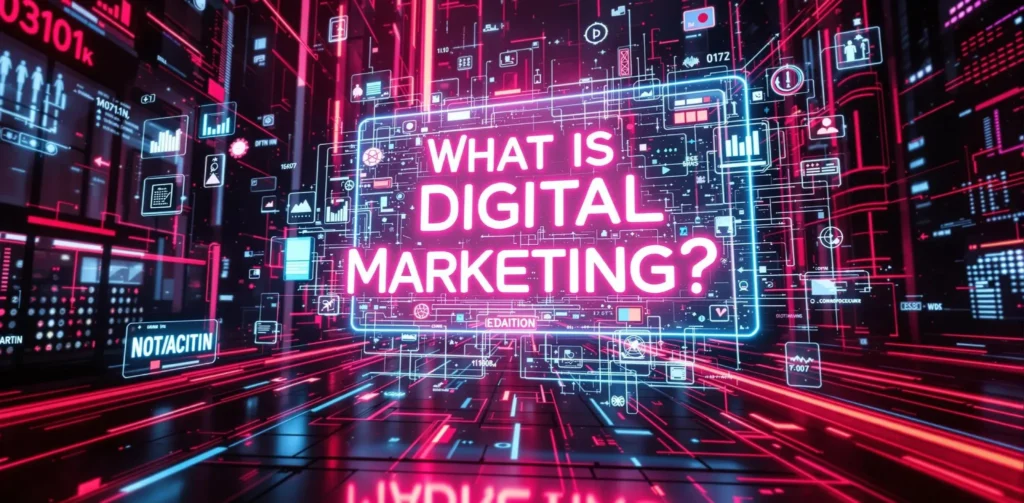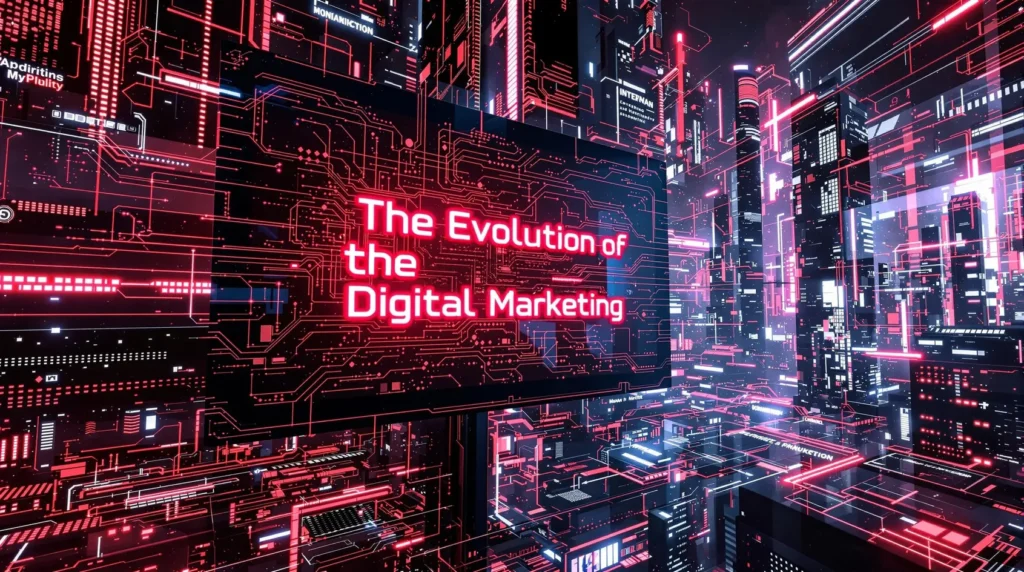In the digital age, marketing has evolved. Traditional methods are no longer enough. Digital marketing encompasses all marketing efforts that use electronic devices or the internet. It’s a broad field, covering everything from content creation to analytics.
But what are the digital marketing basics? This article aims to answer that question. Whether you’re a small business owner, a marketing professional, or just curious, this guide is for you. It’s about improving your online presence, increasing brand awareness, and driving more traffic to your website.
We’ll cover a range of topics. These include SEO basics, social media strategies, and much more. We’ll also explore the different digital marketing channels. From search engines to social media platforms, we’ll discuss how to leverage these channels for maximum impact.
Finally, we’ll look at how to build a digital marketing strategy. We’ll discuss setting clear goals, understanding your audience, and allocating your budget.
What is Digital Marketing?

Digital marketing refers to all marketing activities conducted online. It includes a variety of strategies designed to reach consumers through digital channels. These channels range from websites to social media platforms.
At its core, digital marketing leverages the internet and electronic devices. It enables businesses to connect with target audiences more effectively. This approach contrasts with traditional marketing, which often relies on print ads, billboards, and direct mail.
Several key elements define digital marketing. These include search engine optimization (SEO), content marketing, and online advertising. Each element plays a vital role in a comprehensive digital marketing strategy. Let’s explore some components further:
- Search Engine Optimization (SEO): Enhancing website visibility on search engines like Google.
- Content Marketing: Creating valuable content to engage and educate the target audience.
- Social Media Marketing: Utilizing platforms like Facebook and Instagram for brand promotion.
- Email Marketing: Communicating directly with customers via newsletters and offers.
- Pay-Per-Click (PPC) Advertising: Paying for each click on online ads to drive traffic.
These elements showcase the dynamic nature of digital marketing. Each plays a unique role in attracting and retaining customers. Companies can tailor their approaches based on specific goals and target demographics.
Digital marketing isn’t static; it evolves with technology. As new platforms and tools emerge, marketers must adapt their strategies. This adaptability ensures businesses stay ahead in a fast-paced digital landscape.
In summary, digital marketing is an essential component of modern business. It provides valuable insights, tracks performance, and enhances customer engagement. By embracing these fundamentals, businesses can achieve long-term success.
The Evolution of Digital Marketing

Digital marketing has undergone significant transformation over the years. Its evolution parallels the rapid advancements in technology. Initially, it revolved primarily around basic websites and email marketing campaigns.
In the early internet days, websites were mainly informational. They served as online brochures for businesses. As more users came online, marketers began to see the potential of reaching larger audiences.
With the rise of search engines, SEO became crucial. Businesses recognized the need to rank higher in search results. This shift marked the beginning of more sophisticated digital strategies.
Social media’s emergence marked a new era in digital marketing. Platforms like Facebook and Twitter opened doors for real-time engagement. Marketers could now connect with audiences on a more personal level.
by Philippe Leone (https://unsplash.com/@philinit)
Today, digital marketing encompasses a wide array of tools and tactics. It integrates advanced analytics to measure campaign effectiveness. The focus is not just on reaching audiences but understanding them deeply.
The future of digital marketing remains dynamic. As technology evolves, so will strategies to engage users. Businesses must continually innovate to remain competitive in this ever-changing landscape.
Key Components of Digital Marketing
Digital marketing consists of several key components that work together to create effective marketing strategies. Understanding these components is crucial for anyone looking to improve their online presence. Each component plays a unique role in reaching and engaging with your audience.
- Content Marketing – Creating valuable content tailored to your audience.
- SEO Basics – Optimizing your website to rank higher in search results.
- Social Media Strategies – Engaging with audiences on various social media platforms.
- Email Marketing – Sending targeted emails to engage and convert leads.
- Pay-Per-Click (PPC) Advertising – Running ads for targeted audiences to drive traffic.
- Affiliate Marketing – Partnering with others to promote products and earn commissions.
- Mobile Marketing – Targeting users on mobile devices through optimized experiences.
The components interconnect with one another. A successful digital strategy will utilize them in combination. They help to attract, engage, and convert customers effectively.
Digital Marketing Channels
Digital marketing channels are the pathways to reaching potential customers. Each channel offers unique advantages and supports different strategies. Using multiple channels creates a balanced and comprehensive approach.
There are several key digital marketing channels to consider:
- Search Engines – This channel focuses on appearing in search results to drive traffic.
- Social Media Platforms – Use these platforms to engage and interact with your audience.
- Email – A direct channel for reaching individuals with personalized messages.
- Websites – Serve as the central hub for your online presence.
- Mobile Apps – Engage users with dedicated applications tailored for mobile devices.
Channels like search engines and social media often require different strategies. Understanding the role of each is crucial in crafting an effective marketing plan. Integrating these channels can help maximize reach and engagement.

Building a Digital Marketing Strategy
Crafting an effective digital marketing strategy involves detailed planning and execution. A well-defined strategy aligns with business objectives and market conditions. It requires careful analysis and understanding of various digital channels.
A digital marketing strategy should encompass several key elements:
- Establishing clear and measurable goals
- Understanding and segmenting the target audience
- Allocating budget wisely across chosen channels
- Consistently measuring performance and adjusting tactics
- Ensuring a coherent brand voice across all platforms
Integrating these elements can foster success and drive results. Clarity in strategy helps in maintaining focus and achieving targets. It’s essential to regularly refine and adapt the strategy to market shifts.
Flexibility is crucial in digital marketing. Changes in technology and consumer behavior necessitate ongoing adaptation. An agile strategy allows for swift adjustments to maintain effectiveness.
Feedback from campaigns is invaluable. Insights gained from analytics inform future strategies and help pinpoint areas for improvement. Continuous learning ensures that your strategy evolves with industry trends.
Setting Clear Goals
Setting clear goals is the foundation of any marketing strategy. Goals provide direction and purpose. They guide the allocation of resources and efforts.
Clear, measurable objectives allow for effective tracking of progress. Use specific, attainable targets like increasing website traffic or boosting social media engagement. These goals should align with overarching business objectives.
Realistic timelines should accompany each goal. This helps in achieving systematic progression and maintaining momentum. Regularly review these goals to stay aligned with current priorities.
Understanding Your Audience
A deep understanding of your audience is vital for crafting relevant messages. Knowing your audience’s preferences and behaviors informs content and channel choices.
Demographic and psychographic data aid in segmentation. This allows for tailored strategies targeting various groups effectively. Creating personas can help visualize and address specific audience needs.
Listening to customer feedback provides valuable insights. Engage with audiences across platforms to understand their expectations better. This knowledge enhances relationship-building and increases brand loyalty.
Budget Allocation Across Channels
Budget allocation determines the reach and impact of your strategy. Distributing resources across channels requires strategic consideration. Factor in both short-term and long-term goals.
Each digital channel has different costs and potential returns. Prioritize channels that align with target audience habits and preferences. An experimental budget can also allow for testing new channels or tactics.
Review and adjust your budget regularly. Analyze performance data to optimize allocations, ensuring efficiency and effectiveness. Flexibility in budget planning helps in responding to unexpected market changes.
Measuring Digital Marketing Success
Digital marketing success blends art and science. Data analytics and insights from tracking paid ads, social media channels, and landing pages reveal campaign strengths. By monitoring conversion rates and engagement from every digital marketing campaign, professionals refine strategies to reach their target market and build brand awareness—a truly powerful tool.
Key performance indicators (KPIs) provide measurable insights via conversion, click-through, and bounce rates. Incorporating case studies, affiliate marketing data, and video marketing metrics supports informed decisions. These KPIs help assess paid advertisements and optimize landing pages, ensuring digital marketing efforts consistently align with business objectives.
Robust analytics and transparent reporting turn raw data into strategic action. Monitoring behavior on social platforms and analyzing data from digital marketing campaigns fuels continuous improvement. Industry benchmarks and regular evaluation empower teams to innovate and adjust messaging—keeping the strategy dynamic and effective.
Enhance your digital strategy with our optimization tools. Explore our image compressor, QR code generator, and HTML/CSS/JS minifier-beautifier to streamline media uploads, refine landing pages, and boost your campaign performance.

Digital Marketing Tools and Technologies
The landscape of digital marketing is vast and constantly evolving. Tools and technologies play a crucial role in managing and optimizing marketing efforts. They help streamline processes, enhance productivity, and improve results.
Marketers today have access to an array of tools. These range from SEO and analytics solutions to automation platforms. Each tool serves a specific purpose in the marketing process.
Choosing the right tools depends on your business needs. It’s important to assess the functionalities before implementation. The goal is to ensure they align with your objectives and strategy.
Common digital marketing tools include:
- SEO and Analytics Tools: Essential for performance tracking and optimization.
- Social Media Management Tools: Aid in scheduling and content management.
- Marketing Automation Platforms: Improve campaign efficiency and personalization.
Utilizing digital tools effectively requires skills and understanding. Training and ongoing education are essential for maximizing tool capabilities. The ability to adapt to new technologies is a competitive advantage.
Integrating tools with existing systems can enhance operations. Seamless integration facilitates better data flow and communication. It also supports a unified approach to marketing across various channels.
SEO and Analytics Tools
SEO and analytics tools are foundational for digital marketing success. They provide insights into website performance and search rankings. Tools like Google Analytics offer detailed data on user behavior and traffic sources.
SEO tools help optimize websites for better visibility. They focus on keyword research, backlinks, and technical elements. These insights are crucial for improving search engine rankings.
The right tools can identify strengths and weaknesses. They inform decisions that boost website performance. Having access to reliable SEO analytics helps maintain a competitive edge.
Social Media Management Tools
Social media management tools are vital for handling multiple accounts efficiently. They enable scheduling, content creation, and performance tracking across platforms. Tools like Hootsuite and Buffer offer comprehensive solutions to streamline social media efforts.
These tools also provide analytics to gauge engagement and reach. By understanding these metrics, businesses can refine their social media strategies. This adaptability is key to thriving in a dynamic digital environment.
Additionally, social media tools help with community management. Engaging with followers and managing interactions becomes manageable. This fosters better relationships and enhances brand loyalty.
Marketing Automation Platforms
Marketing automation platforms revolutionize how campaigns are managed. They enable marketers to automate repetitive tasks with precision. Platforms like HubSpot and Marketo are popular choices for their robust features.
Automation enhances personalization and efficiency in campaigns. It allows marketers to segment audiences and tailor communications. This level of customization improves conversion rates and customer satisfaction.
These platforms also support lead management and nurturing. By automating email workflows, they keep prospects engaged throughout the sales funnel. Seamless lead management translates to better revenue opportunities.
Trends and Future of Digital Marketing
Digital marketing is a powerful tool that rapidly evolves with changing technology and consumer behavior. Savvy marketers harness dynamic digital marketing campaigns that leverage data analytics, paid ads, affiliate marketing, and case studies to effectively engage their target market across social media channels and optimized landing pages.
Emerging trends like video marketing and interactive content drive brand awareness and enhance user experience on social platforms. AI-powered personalization and voice search SEO now shape messaging strategies, while omnichannel marketing ensures paid advertisements resonate across devices.
Conclusion: Integrating Digital Marketing Basics into Your Business
Understanding digital marketing basics is essential for modern businesses. It provides the foundation needed to compete online. With this knowledge, you can effectively reach and engage your audience.
To integrate these fundamentals, begin by setting clear goals. Define what success looks like for your business. Use these goals to guide your marketing strategies across channels.
Focus on understanding your target audience deeply. Tailor your content and campaigns to meet their needs. Personalization fosters stronger connections and increases customer loyalty.
Finally, embrace continuous learning and adaptation. The digital landscape shifts rapidly, requiring ongoing adjustments. By staying informed and flexible, you will maximize your marketing impact and drive business growth.
Frequently Asked Questions
Digital marketing may seem overwhelming at first. However, breaking it into manageable steps makes the learning process smoother. Let’s explore some common questions beginners often have.
What are the first steps in learning digital marketing?
Begin by understanding the core concepts. This includes SEO, social media, and content marketing. Learn how each component works within digital marketing.
Next, familiarize yourself with essential tools and platforms. Explore online courses and certification programs. These resources provide a structured path to grasp these concepts effectively.
How can small businesses benefit from digital marketing?
Digital marketing levels the playing field for small businesses. It allows them to compete with larger companies by reaching a broad audience. With targeted strategies, small businesses can amplify their presence without a huge budget.
Moreover, these businesses can build strong relationships with their customers. Personalized messaging and engagement on social media enhance brand loyalty. This leads to increased customer retention and growth.

